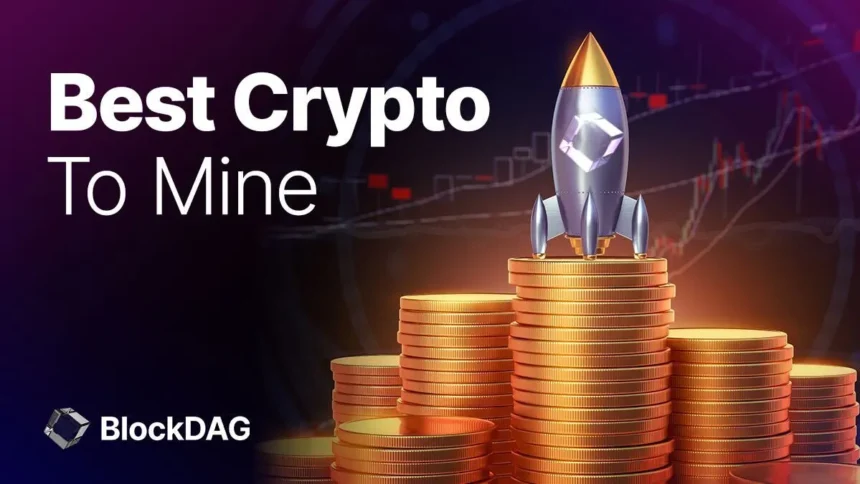Blockchain technology has taken the world by storm. Its decentralized nature and ability to secure transactions have transformed industries from finance to supply chain management. However, as with any innovation, it comes with its own set of challenges. Enter BlockDAG—a revolutionary approach that promises to address the limitations of traditional blockchain systems.
Imagine a network where transactions can occur simultaneously without waiting in line for validation. Picture a structure that not only enhances scalability but also boosts efficiency and reduces costs. This is what BlockDAG offers, and it’s time to dive into this groundbreaking technology that could redefine how we view digital ledgers forever.
Are you curious about how BlockDAG works? Or why it’s gaining traction among developers and companies alike? Let’s explore!
Understanding Blockchain Technology
Blockchain technology is a decentralized digital ledger that records transactions across multiple computers. This ensures that no single entity has control over the entire chain, promoting transparency and security.
Each block in the blockchain contains a list of transactions. Once filled, it links to the previous block through cryptographic hashes, creating an unalterable sequence. This structure makes tampering nearly impossible.
The distributed nature of blockchain enhances trust among users. Each participant on the network can verify their own copy of the transaction history without relying solely on intermediaries.
Smart contracts further expand its capabilities by automating agreements based on predetermined conditions. This reduces delays and minimizes human error, paving the way for innovative applications across various sectors.
Despite its growth and potential, traditional blockchain systems face challenges like scalability issues and high transaction costs as adoption increases.
Limitations of Traditional Blockchain
Traditional blockchain technology has garnered significant attention, but it is not without its pitfalls. Scalability remains a prominent concern. As more transactions occur, networks can become congested, leading to slower processing times.
Another limitation is the energy consumption associated with proof-of-work mechanisms. The vast amount of computational power required for mining consumes immense resources and raises environmental concerns.
Centralization risks also exist in some blockchain models. While the goal is decentralization, certain platforms may end up relying on a few dominant nodes that control network activity.
Interoperability issues hinder communication between different blockchains. This fragmentation complicates user experience and limits seamless transactions across various platforms. These challenges suggest that while traditional blockchain offers innovative solutions, there are critical areas needing improvement before widespread adoption can be fully realized.
Introduction to BlockDAG
BlockDAG, short for Directed Acyclic Graph, offers an innovative twist on traditional blockchain architecture. Unlike the linear chain of blocks found in conventional blockchains, BlockDAG allows multiple nodes to process transactions simultaneously.
This structure enables a more flexible and scalable approach. Each transaction can link to several others rather than being confined to a single sequence. As a result, it significantly reduces bottlenecks often seen in standard blockchains.
With its unique design, BlockDAG fosters faster confirmation times and increased throughput. This means that as the network grows, performance does not degrade but instead improves through parallel processing capabilities.
Emerging projects are exploring this technology for various use cases. From cryptocurrencies to supply chain tracking, BlockDAG has the potential to enhance efficiency across industries while maintaining security and decentralization principles.
How Does BlockDAG Work?
BlockDAG operates on a different principle than traditional blockchain structures. Instead of a linear chain, it functions as a directed acyclic graph. Each transaction can connect to multiple previous transactions rather than just one.
When a user initiates a transaction, the system verifies its legitimacy by checking against earlier validations in the network. This decentralized approach allows for numerous confirmations happening simultaneously, vastly improving speed and throughput.
As new transactions are added, they create branches within the graph. These branches help distribute data across many nodes instead of relying on a single point of validation.
This structure reduces bottlenecks often seen in conventional blockchains and enhances scalability. With BlockDAG, every node contributes to consensus without waiting in line for their turn to validate blocks, fostering an efficient environment for rapid exchanges and interactions.
Advantages of BlockDAG
BlockDAG technology offers multiple advantages that address the limitations of traditional blockchain systems. One key benefit is scalability. Unlike linear blockchains, BlockDAG allows for multiple transactions to be processed simultaneously. This leads to faster transaction times and reduced congestion.
Another compelling advantage is enhanced security. Each transaction in a BlockDAG structure confirms multiple previous ones, creating a web of interconnections that makes it difficult for malicious actors to manipulate the network. The decentralized nature also fortifies resistance against attacks.
Moreover, BlockDAG fosters greater flexibility in terms of consensus mechanisms. Various algorithms can be employed based on specific use cases, allowing developers to tailor solutions according to their needs without being restricted by predefined protocols.
This adaptability opens doors for innovations across diverse industries, paving the way for more efficient and effective applications of distributed ledger technology.
Potential Applications of BlockDAG
BlockDAG technology opens the door to a myriad of groundbreaking applications. One prominent area is in financial transactions. Its ability to facilitate rapid processing times allows for real-time settlements, transforming how businesses handle payments.
Supply chain management could also benefit significantly from BlockDAG’s structure. It enhances transparency and traceability, providing stakeholders with real-time data on product movement and authenticity.
In healthcare, BlockDAG can secure patient records while enabling seamless sharing among authorized entities. This ensures privacy without sacrificing accessibility.
Furthermore, its scalability makes it suitable for IoT devices that require efficient communication between numerous endpoints. By utilizing BlockDAG, these devices can interact securely and instantly.
Even gaming platforms stand to gain from this technology; decentralized game economies can thrive with quicker transaction speeds and reduced costs associated with traditional blockchain methods. The versatility of BlockDAG creates opportunities across various sectors waiting to be explored.
Future of BlockDAG and its Impact on the Industry
The future of BlockDAG holds immense promise for various sectors. As industries seek faster, more efficient solutions, BlockDAG’s unique structure could redefine scalability in blockchain technology.
With its ability to process multiple transactions simultaneously, it can alleviate congestion issues that plague traditional blockchains. This means quicker confirmations and a seamless user experience.
Moreover, as businesses increasingly prioritize security and decentralization, BlockDAG offers an attractive alternative. Its architecture minimizes the risk of central points of failure while enhancing data integrity.
Innovative applications are already emerging across finance, supply chain management, and even healthcare. Companies looking to harness this technology will likely find themselves at a competitive advantage.
As developers continue to explore new use cases, the impact on industry standards could be transformative. We may witness a shift towards more adaptable frameworks that challenge existing norms in decentralized technologies.
Conclusion
Blockchain technology has brought about significant changes in the way we think about data and transactions. Yet, it is not without its limitations. Traditional blockchain systems face challenges with scalability, speed, and energy consumption. These issues have led to the exploration of alternative frameworks like BlockDAG.
BlockDAG presents a fresh approach by allowing multiple blocks to be created simultaneously, rather than sequentially as seen in traditional blockchains. This innovative structure promotes greater transaction throughput and enhanced efficiency.
As BlockDAG continues to evolve, its advantages—such as reduced latency, increased scalability, and lower costs—are becoming increasingly clear. The potential applications are vast too; from supply chain management to Internet of Things (IoT) devices and beyond.
Looking ahead, BlockDAG may reshape industries significantly by overcoming many obstacles faced by traditional blockchain technologies. Its unique architecture could pave the way for more robust decentralized applications that cater to real-world needs effectively.
The future seems promising for BlockDAG as it positions itself at the forefront of technological advancement within blockchain ecosystems.


